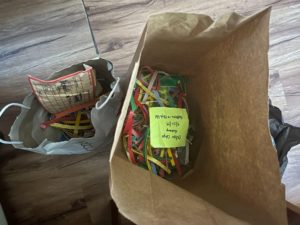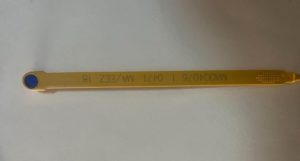Natalie MacDonald, 2021 Joanna Toole Intern
When I originally started contemplating what I would consider as “ghost gear” at the beginning of this internship, I thought of lobster traps, netting, and rope — large gear that’s easy to spot and what I thought was most likely to get lost or be discarded. But plenty of small pieces of gear are a source of marine debris as well. Lobster trap tags and lobster bands still make up a substantial portion of what I have seen during the beach cleanups I’ve participated in.
One duty I’ve taken on as the Joanna Toole intern is logging all of the lobster trap tags from the past two years that hadn’t been recorded yet. Some were found during organized cleanups, while others were collected and brought to the CCS Marine Debris department by volunteers. Right off the bat I can say that the number of tags collected in the past two years just about took over my living room. They are a huge source of marine debris, maybe not by weight, but by numeration.
I would categorize logging the tags as a monotonous task, but definitely not a boring one. You can learn a lot from each tag. Each one tells you the state it was from, the year it was registered, and sometimes the region. Many come from Massachusetts and Maine, but some from New Hampshire and even Canada show up from time to time. If you look more closely, you can infer even more about why it has become debris. Many are found broken, while some were deliberately cut off, and occasionally there are some still fully intact or never been used.
Many broken tags broke at the connecting point, which originally led me to believe that maybe they were actually ripped off. But I was corrected, and told that that part of the tag was just most vulnerable to breakage. While the polyethylene or polypropylene tags are brightly colored and easy to spot and attach, they are not a great option for durability. Because they can break off or become lost, a lobsterman is allowed to obtain one tag per trap each season (up to 800 tags), plus ten percent in the case of a loss.
In the United States, you must register and put new tags on your traps every year. Canada has some different regulations for tagging traps. Fisheries and Ocean Canada (DFO) uses a single-year as well as a multi-year tag program. The multi-year tags are good for three years, which reduces the potential number of tags lost or discarded each year.
Some regulations require you to remove old tags before attaching new ones, which can explain why some are deliberately cut off, although that does not excuse them from becoming debris. Logging all of the tags we find and what state we find them in is so important to understanding how we might develop solutions to limit the debris – even the small bits – created by the lobster industry.
Above, from left to right: a fully intact tag, a tag that was cut, and a broken tag.

Our Work
Humpback Whale Research
Right Whale Research
Marine Animal Entanglement Response
Marine Geology Department
Water Quality Monitoring Program
Marine Fisheries Research
Seal Research
Shark Research
Marine Education
Interdisciplinary
Marine Debris and Plastics Program
Marine Policy Initiative
Cape Cod Climate Change Collaborative
Publications





